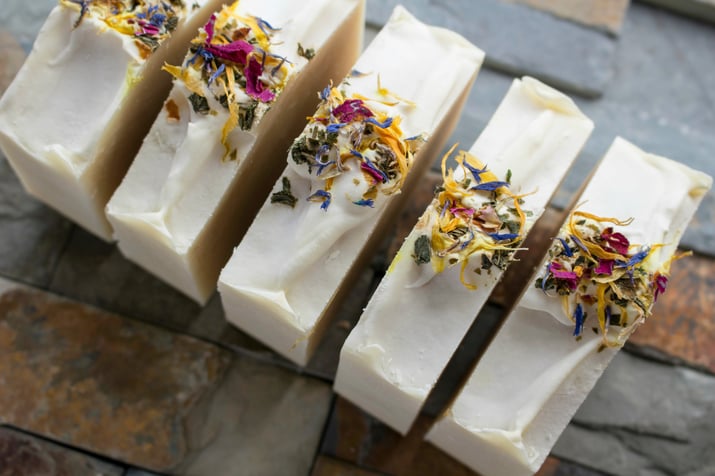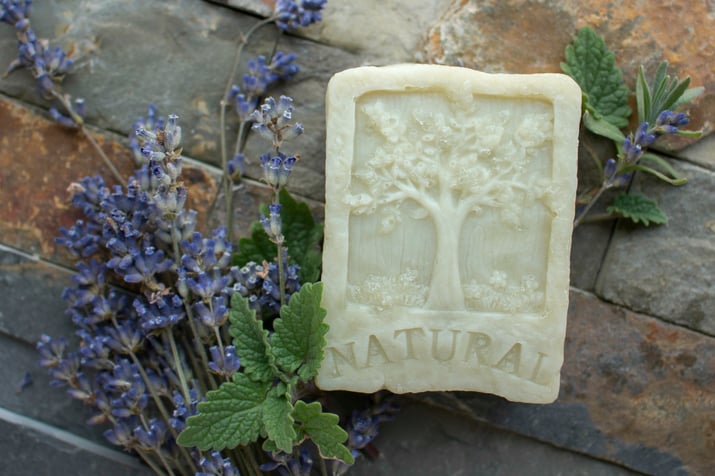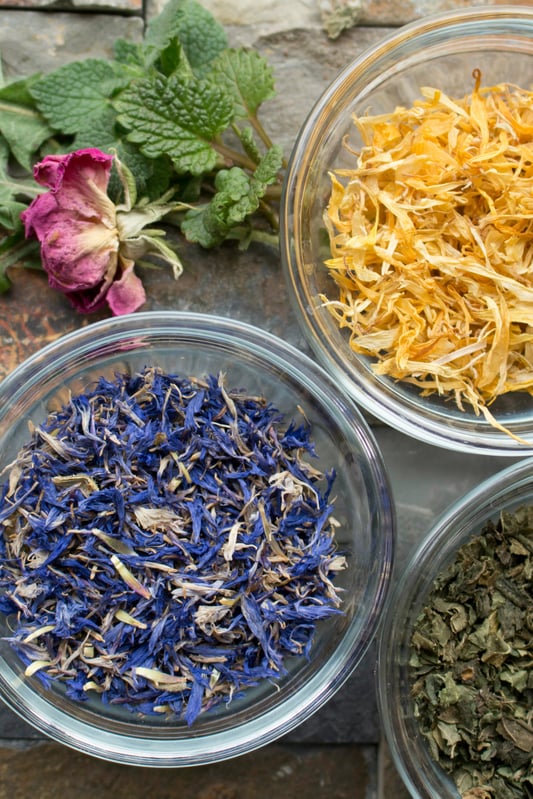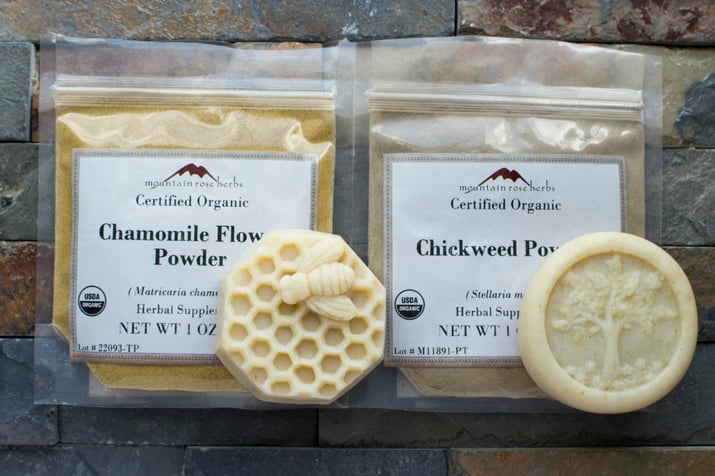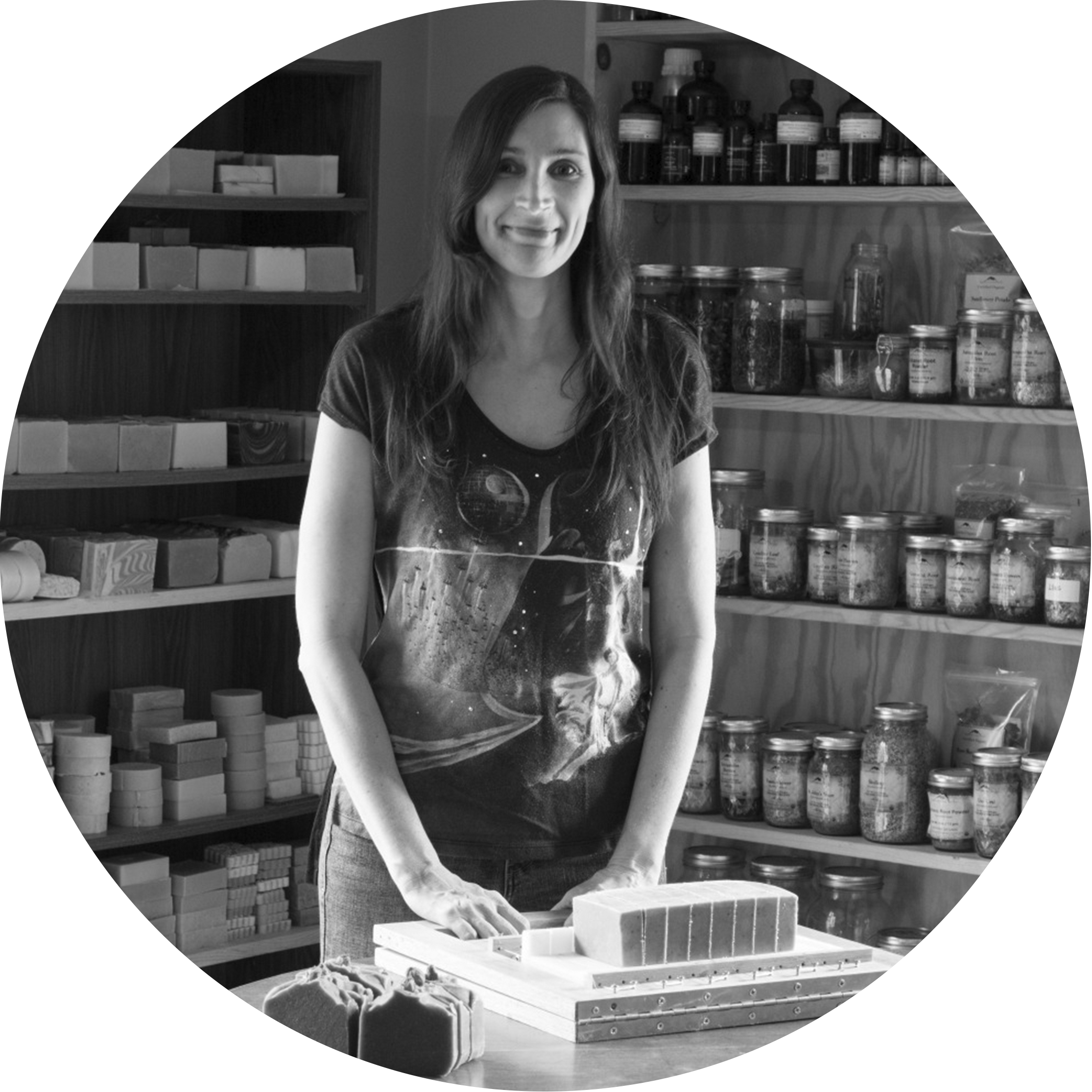Besides being a practical skill to know, making your own soap from scratch is a fun way to express yourself creatively while producing something that's useful and great for your skin. By following this simple recipe, you can make basic unscented bars of soap, or customize them by adding organic herbs, flowers, essential oils, and other skin-loving ingredients.
In times past, our foremothers made their own soap using animal fat and a wood ash solution deemed ready when it was caustic enough to dissolve a chicken feather. These days, the modern soap maker uses a standardized lye, called sodium hydroxide, to ensure consistent and reliable results.
You may wonder, as I did too, how a strong substance such as lye can produce soaps gentle enough to use on even the most sensitive skin types.
While it doesn’t seem to make sense at first thought, from a chemistry standpoint it’s absolutely necessary. You must use a highly alkaline solution, such as sodium hydroxide, in order to transform oils into soap. In the presence of heat and water, the fatty acids and glycerol in oils bond with the sodium and hydroxide portions of lye to form brand new substances—soap, plus glycerin—which are great for your skin. No lye remains in the final soap.
Soap Making Equipment
- Digital scale: ingredients are measured by weight, not volume
- Thermometer: to monitor temperatures
- Immersion blender: for easier mixing
- Container for lye solution: stainless steel or heavy-duty plastic (recycle #5)
- Container for mixing soap: stainless steel, heavy-duty plastic, or heatproof glass
- Gloves & goggles: to protect hands and eyes
- Spatulas & spoons: silicone or heatproof plastic
- Soap mold: 2.5 lb. soap mold, empty milk carton, or silicone molds
Important: Don’t use aluminum or non-stick equipment since those substances react negatively with lye.
DIY Herbal Soap Recipe
Makes around 2.5 pounds of soap, or about 7 to 8 bars when using a loaf mold.
Ingredients
- 9.5 oz. distilled water (or cooled herbal infusion)
- 3.85 oz. sodium hydroxide (lye)
- 12 oz. organic olive oil
- 7 oz. organic coconut oil
- 4 oz. organic shea, cocoa, or kokum butter
- 3.5 oz. organic sunflower or sweet almond oil
- 1.5 oz. organic castor oil
- Organic herbs, flowers, or organic essential oils (optional)
Directions
If you’re a new to soap making, be sure to review the tips and tricks below before you get started.
- Put on your goggles & gloves.
- Weigh water (or herbal infusion) into stainless steel or heavy-duty plastic container.
- Weigh lye into a small cup.
- Sprinkle lye into the water.
- Stir well until lye completely dissolves.
- Place lye solution in safe area and cool for 30 to 40 minutes, or until it's about 100° to 115° F.
- Melt coconut oil and butter over low heat, then combine with other oils.
- Cool combined oils until they’re around 95° to 115° F.
- Pour cooled lye solution into warm oils.
- Use combination of hand stirring and short bursts of the immersion blender to mix oils and lye solution.
- Mix until soap reaches trace.
- Pour soap into mold.
- If you’d like, use spoon to texture the top of soap then decorate with flower petals such as cornflower, calendula, or rose.
- Cover soap lightly with piece of wax paper or parchment paper.
- Cover with towel or blanket to insulate.
- Allow to set for one to two days before removing from mold.
- Turn out soap on a piece of wax paper.
- Cut soap into bars.
- Space bars out on wax paper or coated cooling rack ensuring plenty of airflow between them.
- Rotate every few days allowing for an even cure.
- Cure in open air for 4 to 6 weeks before use.
Pro Tips
- When mixing, your lye solution will get hot quickly, so be sure to handle with care. Work outside, in front of an open window, or under an exhaust fan and avoid breathing in the momentarily strong fumes.
- When combining your warmed oils and lye solution, don’t overuse the immersion blender or you’ll create excess air bubbles, and the soap will thicken too quickly.
- When you’ve reached trace, the soap batter will have a consistency similar to thin pudding or warm custard. You can test for “trace” by drizzling a spoonful of the soap batter across its surface in the mixing bowl. It should leave a brief but noticeable mark, or tracing, before sinking back in. Trace usually takes anywhere from 3 to 10 minutes to reach, depending on ingredient temperatures and how often you use the immersion blender.
- If you’re making soap when your house is cold, cover it with a few extra layers.
- It’s okay to briefly peek at your soap every now and then. If you see a crack developing, that means it’s getting too hot and should be uncovered and moved to a cooler area.
- After an hour or two after mixing, you'll notice that the soap is getting darker in the middle and might look jelly-like in spots. This stage is called gel phase and is perfectly normal.
- If your soap is still a bit soft when you turn it out of your mold wait a few days before cutting it into bars.
Customizing Your Recipe
There are several ways to incorporate herbs, flowers, and other nourishing ingredients into soap recipes. While some herbal constituents won’t survive the soap making process, others are surprisingly resistant to the alkaline conditions and heat.
Instead of plain distilled water, try using a chilled herbal tea in its place. It can be as simple as chamomile tea, or a complex blend of your favorite herbs. Take note that a strong, dark tea will often yield soap with a brown hue, while some herbs, such as organic chlorella and wheatgrass, act as natural colorants.
Another way to enrich your soaps is to infuse all or part of the oils with skin soothing herbs, including organic calendula, organic chamomile, or organic plantain. Some herbs and flowers will add a subtle hint of color to your soap as well.
A third way to incorporate ingredients such as oatmeal, honey, essential oils, clay, or organic herbal powders is to blend them into the soap batter when you reach trace.
3 Customization Examples
The following examples show how easy it is to create unique variations using the same simple soap recipe above, with the addition of just a few additives.
Chamomile & Honey Soap
Make the soap as directed, adding 1 1/2 tsp. organic chamomile flower powder and 1 1/2 tsp. honey at trace.
Tip: Dilute the honey with an equal amount of warm water first to help it mix into the soap batter more readily.
French Green Clay & Peppermint
Make the soap as directed, adding 1 Tbsp. french green clay and 24 grams organic peppermint essential oil at trace.
Tip: Dilute clay with 2 to 3 times the amount of water first to make sure it blends into the soap evenly.
Chickweed & Oatmeal
Make the soap as directed, adding 1 1/2 tsp. organic chickweed powder and 1 Tbsp. ground oatmeal at trace.
Tip: Process rolled oats from the grocery store in a coffee grinder to form a fine oatmeal powder that’s perfect for soap making. Avoid using larger pieces as they can mold.
Making your own soap from scratch is an enjoyable pastime that will reward you with lovely bars of soap containing ingredients that you can feel good about using. Once you make that first successful batch, you’re likely to be hooked. There’s a world of ingredient options to explore and virtually unlimited ways to combine them!
Looking for more soapy Herbal Fun?
Try This Soothing Calendula Soap Recipe
You may also be interested in:

